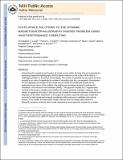State-space solutions to the dynamic magnetoencephalography inverse problem using high performance computing
Author(s)
Long, Christopher J.; Purdon, Patrick L.; Temereanca, Simona; Desai, Neil U.; Hamalainen, Matti S.; Brown, Emery N.; ... Show more Show less
DownloadBrown-STATE-SPACE SOLUTIONS TO THE DYNAMIC.pdf (2.154Mb)
OPEN_ACCESS_POLICY
Open Access Policy
Creative Commons Attribution-Noncommercial-Share Alike
Terms of use
Metadata
Show full item recordAbstract
Determining the magnitude and location of neural sources within the brain that are responsible for generating magnetoencephalography (MEG) signals measured on the surface of the head is a challenging problem in functional neuroimaging. The number of potential sources within the brain exceeds by an order of magnitude the number of recording sites. As a consequence, the estimates for the magnitude and location of the neural sources will be ill-conditioned because of the underdetermined nature of the problem. One well-known technique designed to address this imbalance is the minimum norm estimator (MNE). This approach imposes an L{superscrip 2] regularization constraint that serves to stabilize and condition the source parameter estimates. However, these classes of regularizer are static in time and do not consider the temporal constraints inherent to the biophysics of the MEG experiment. In this paper we propose a dynamic state-space model that accounts for both spatial and temporal correlations within and across candidate intracortical sources. In our model, the observation model is derived from the steady-state solution to Maxwell’s equations while the latent model representing neural dynamics is given by a random walk process. We show that the Kalman filter (KF) and the Kalman smoother [also known as the fixed-interval smoother (FIS)] may be used to solve the ensuing high-dimensional state-estimation problem. Using a well-known relationship between Bayesian estimation and Kalman filtering, we show that the MNE estimates carry a significant zero bias. Calculating these high-dimensional state estimates is a computationally challenging task that requires High Performance Computing (HPC) resources. To this end, we employ the NSF Teragrid Supercomputing Network to compute the source estimates. We demonstrate improvement in performance of the state-space algorithm relative to MNE in analyses of simulated and actual somatosensory MEG experiments. Our findings establish the benefits of high-dimensional state-space modeling as an effective means to solve the MEG source localization problem.
Date issued
2011-06Department
Harvard University--MIT Division of Health Sciences and Technology; Massachusetts Institute of Technology. Department of Brain and Cognitive Sciences; Massachusetts Institute of Technology. Department of Electrical Engineering and Computer ScienceJournal
Annals of Applied Statistics
Publisher
Institute of Mathematical Statistics
Citation
Long, Christopher J. et al. “State-space Solutions to the Dynamic Magnetoencephalography Inverse Problem Using High Performance Computing.” The Annals of Applied Statistics 5.2B (2011): 1207–1228.
Version: Author's final manuscript
ISSN
1932-6157